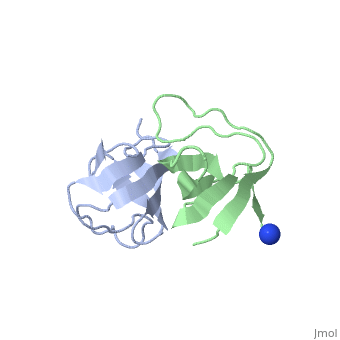2j05: Difference between revisions
No edit summary |
No edit summary |
||
| Line 3: | Line 3: | ||
== Structural highlights == | == Structural highlights == | ||
<table><tr><td colspan='2'>[[2j05]] is a 2 chain structure with sequence from [http://en.wikipedia.org/wiki/Homo_sapiens Homo sapiens]. Full crystallographic information is available from [http://oca.weizmann.ac.il/oca-bin/ocashort?id=2J05 OCA]. For a <b>guided tour on the structure components</b> use [http://oca.weizmann.ac.il/oca-docs/fgij/fg.htm?mol=2J05 FirstGlance]. <br> | <table><tr><td colspan='2'>[[2j05]] is a 2 chain structure with sequence from [http://en.wikipedia.org/wiki/Homo_sapiens Homo sapiens]. Full crystallographic information is available from [http://oca.weizmann.ac.il/oca-bin/ocashort?id=2J05 OCA]. For a <b>guided tour on the structure components</b> use [http://oca.weizmann.ac.il/oca-docs/fgij/fg.htm?mol=2J05 FirstGlance]. <br> | ||
</td></tr><tr><td class="sblockLbl"><b>[[Non-Standard_Residue|NonStd Res:]]</b></td><td class="sblockDat"><scene name='pdbligand=MSE:SELENOMETHIONINE'>MSE</scene></td></tr> | </td></tr><tr id='NonStdRes'><td class="sblockLbl"><b>[[Non-Standard_Residue|NonStd Res:]]</b></td><td class="sblockDat"><scene name='pdbligand=MSE:SELENOMETHIONINE'>MSE</scene></td></tr> | ||
<tr><td class="sblockLbl"><b>[[Related_structure|Related:]]</b></td><td class="sblockDat">[[1wer|1wer]], [[1wq1|1wq1]], [[2j06|2j06]]</td></tr> | <tr id='related'><td class="sblockLbl"><b>[[Related_structure|Related:]]</b></td><td class="sblockDat">[[1wer|1wer]], [[1wq1|1wq1]], [[2j06|2j06]]</td></tr> | ||
<tr><td class="sblockLbl"><b>Resources:</b></td><td class="sblockDat"><span class='plainlinks'>[http://oca.weizmann.ac.il/oca-docs/fgij/fg.htm?mol=2j05 FirstGlance], [http://oca.weizmann.ac.il/oca-bin/ocaids?id=2j05 OCA], [http://www.rcsb.org/pdb/explore.do?structureId=2j05 RCSB], [http://www.ebi.ac.uk/pdbsum/2j05 PDBsum]</span></td></tr> | <tr id='resources'><td class="sblockLbl"><b>Resources:</b></td><td class="sblockDat"><span class='plainlinks'>[http://oca.weizmann.ac.il/oca-docs/fgij/fg.htm?mol=2j05 FirstGlance], [http://oca.weizmann.ac.il/oca-bin/ocaids?id=2j05 OCA], [http://www.rcsb.org/pdb/explore.do?structureId=2j05 RCSB], [http://www.ebi.ac.uk/pdbsum/2j05 PDBsum]</span></td></tr> | ||
<table> | </table> | ||
== Evolutionary Conservation == | == Evolutionary Conservation == | ||
[[Image:Consurf_key_small.gif|200px|right]] | [[Image:Consurf_key_small.gif|200px|right]] | ||
| Line 33: | Line 33: | ||
</StructureSection> | </StructureSection> | ||
[[Category: Homo sapiens]] | [[Category: Homo sapiens]] | ||
[[Category: Gajhede, M | [[Category: Gajhede, M]] | ||
[[Category: Kristensen, O | [[Category: Kristensen, O]] | ||
[[Category: Ross, B | [[Category: Ross, B]] | ||
[[Category: Disease mutation]] | [[Category: Disease mutation]] | ||
[[Category: Gtpase activating protein]] | [[Category: Gtpase activating protein]] | ||
Revision as of 16:22, 19 January 2015
CRYSTAL STRUCTURE OF THE RASGAP SH3 DOMAIN AT 1.5 ANGSTROM RESOLUTIONCRYSTAL STRUCTURE OF THE RASGAP SH3 DOMAIN AT 1.5 ANGSTROM RESOLUTION
Structural highlights
Evolutionary Conservation Check, as determined by ConSurfDB. You may read the explanation of the method and the full data available from ConSurf. Publication Abstract from PubMedX-ray structures of two crystal forms of the Src homology 3 domain (SH3) of the Ras GTPase activating protein (RasGAP) were determined at 1.5 and 1.8A resolution. The overall structure comprises a single domain with two tightly packed beta-sheets linked by a short helical segment. An important motif for peptide binding in other SH3 domains is not conserved in RasGAP. The RasGAP SH3 domain forms dimers in the crystal structures, which may provide new functional insight. The dimer interface involves residues also present in a peptide previously identified as an apoptotic sensitizer of tumor cells. High resolution crystal structures of the p120 RasGAP SH3 domain.,Ross B, Kristensen O, Favre D, Walicki J, Kastrup JS, Widmann C, Gajhede M Biochem Biophys Res Commun. 2007 Feb 9;353(2):463-8. Epub 2006 Dec 18. PMID:17188236[1] From MEDLINE®/PubMed®, a database of the U.S. National Library of Medicine. See AlsoReferences
|
| ||||||||||||||||||
